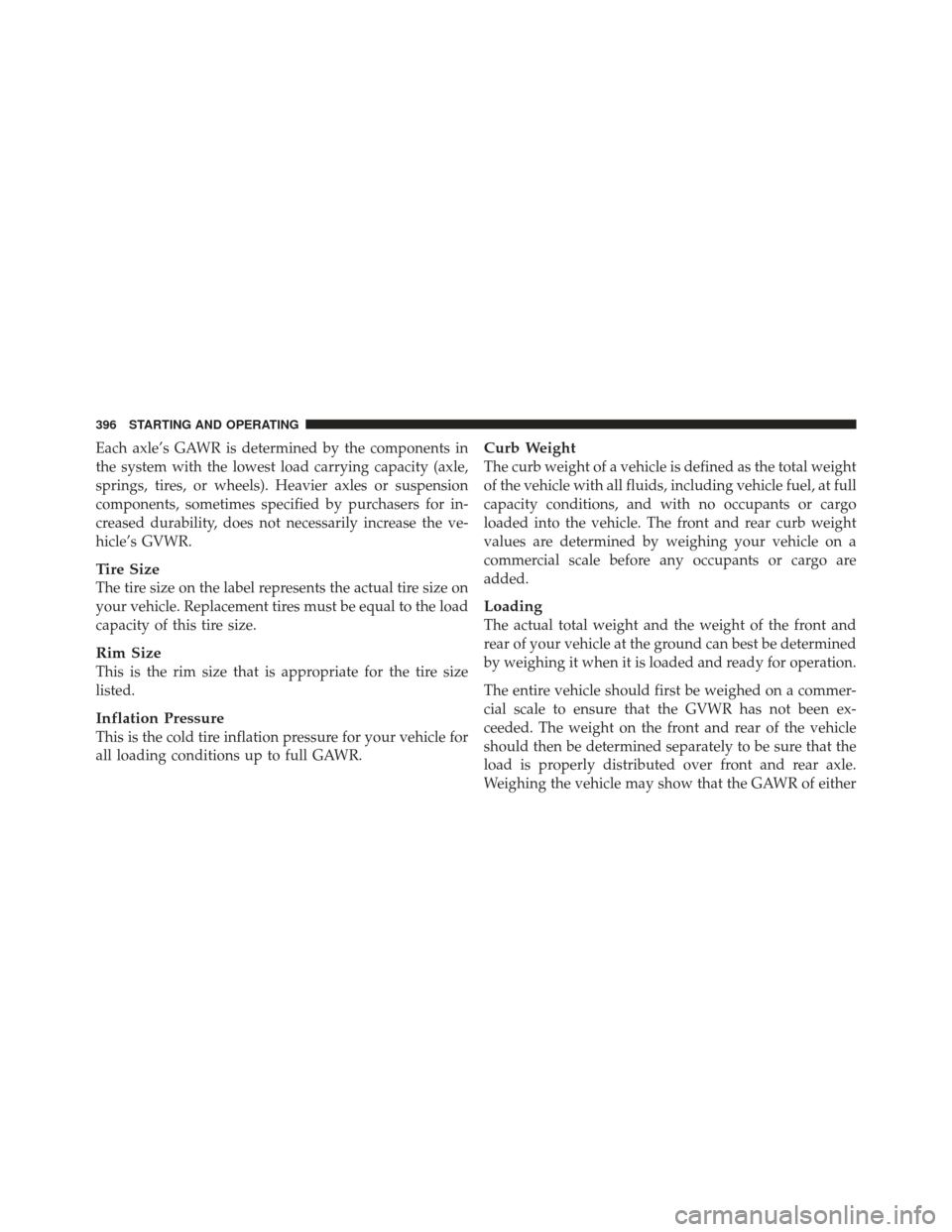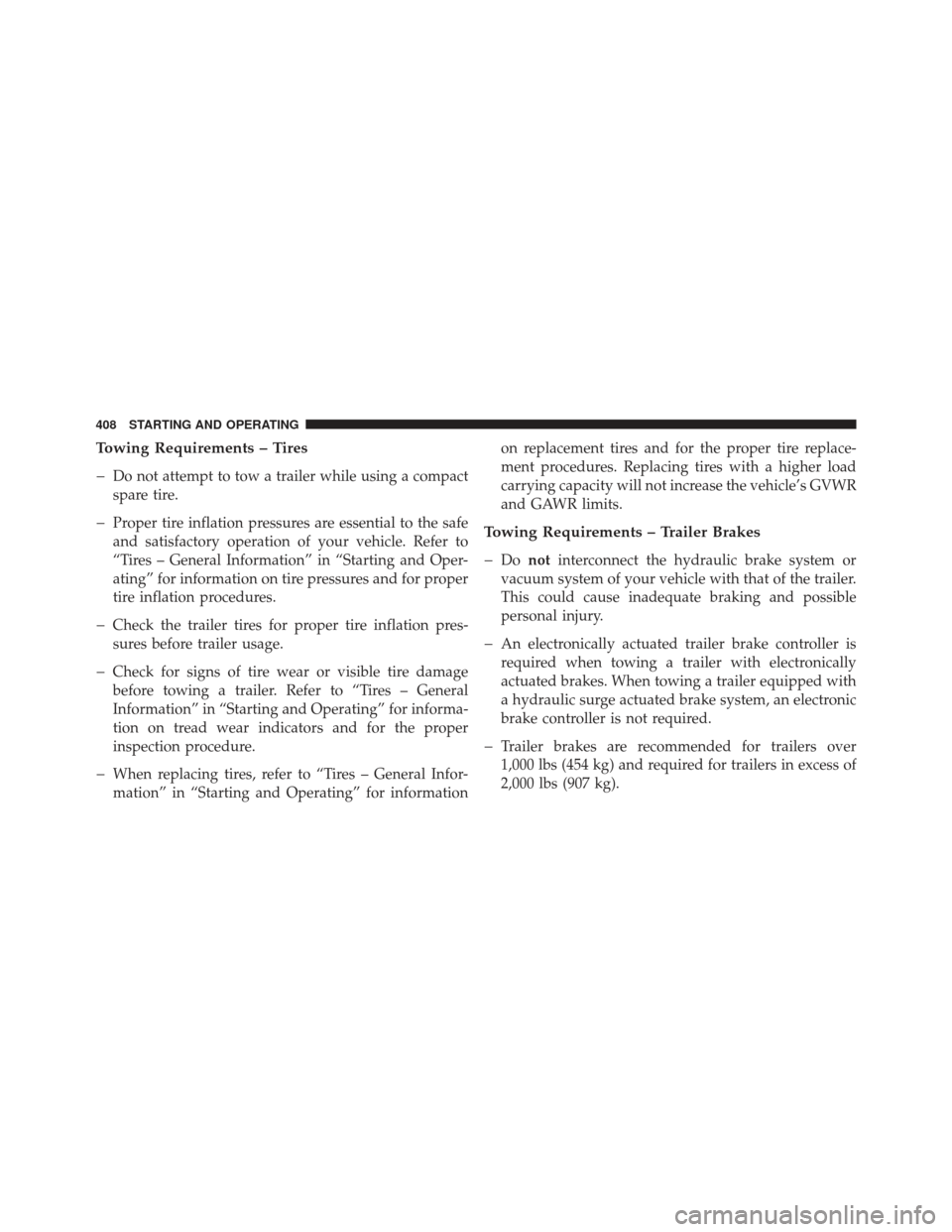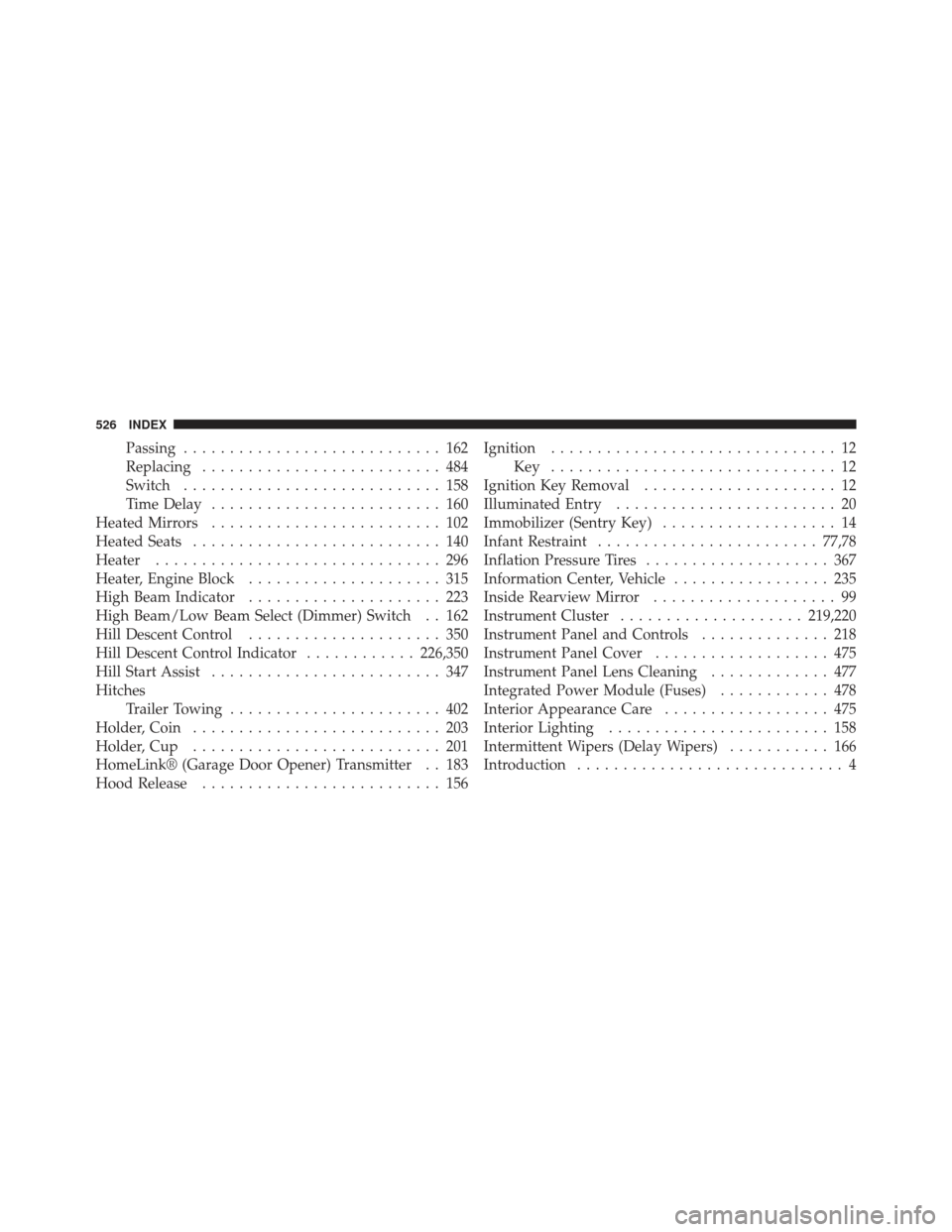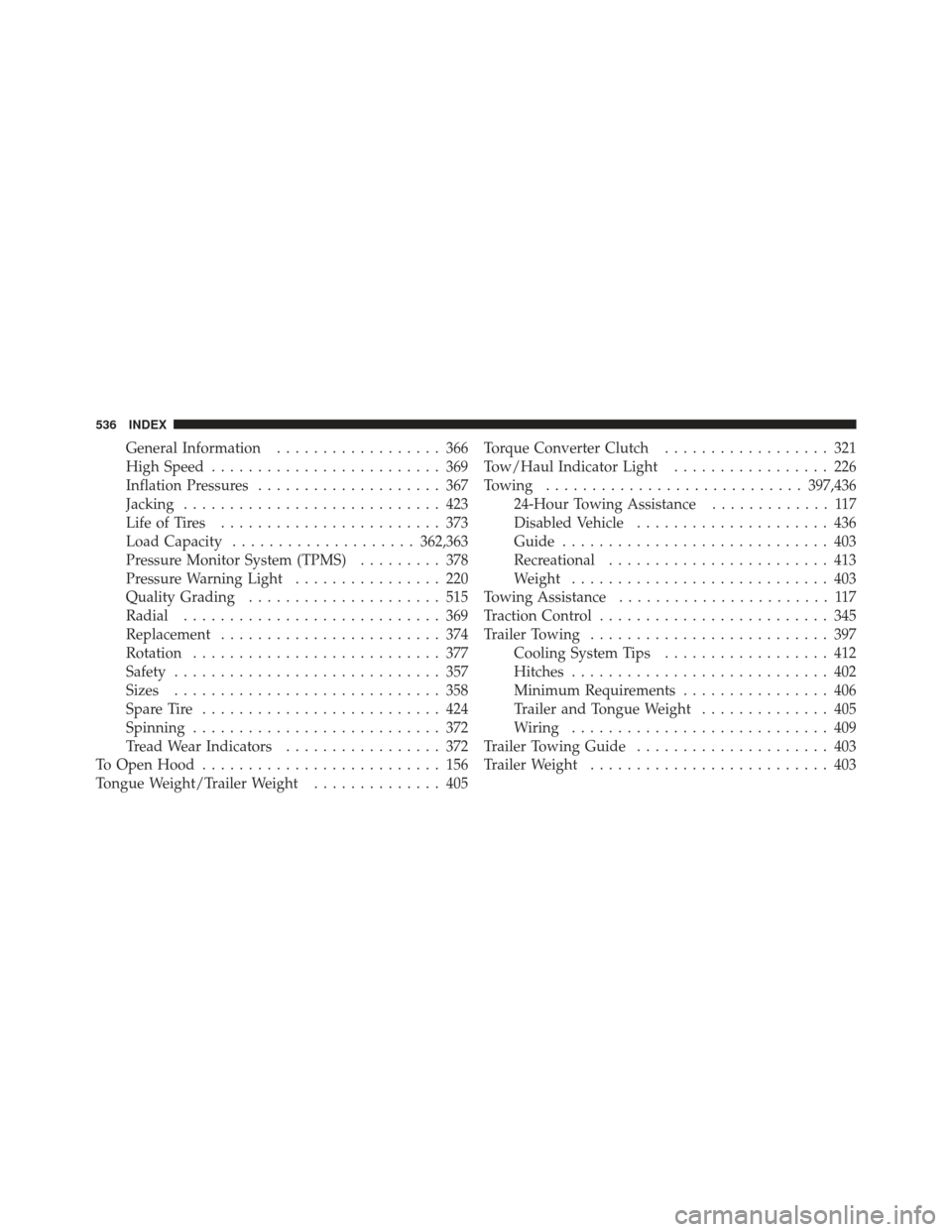2011 JEEP LIBERTY inflation pressure
[x] Cancel search: inflation pressurePage 382 of 542

CAUTION! (Continued)
•After inspecting or adjusting the tire pressure,
always reinstall the valve stem cap. This will
prevent moisture and dirt from entering the valve
stem, which could damage the Tire Pressure Moni-
toring Sensor.
NOTE:
•The TPMS is not intended to replace normal tire care
and maintenance, or to provide warning of a tire
failure or condition.
•The TPMS should not be used as a tire pressure gauge
while adjusting your tire pressure.
•Driving on a significantly under-inflated tire causes
the tire to overheat and can lead to tire failure.
Under-inflation also reduces fuel efficiency and tire
tread life, and may affect the vehicle’s handling and
stopping ability.
•The TPMS is not a substitute for proper tire mainte-
nance, and it is the driver ’s responsibility to maintain
correct tire pressure using an accurate tire pressure
gauge, even if under-inflation has not reached the
level to trigger illumination of the “Tire Pressure
Monitoring Telltale Light.”
•Seasonal temperature changes will affect tire pressure,
and the TPMS will monitor the actual tire pressure in
the tire.
Base System
The Tire Pressure Monitor System (TPMS) uses wireless
technology with wheel rim mounted electronic sensors to
monitor tire pressure levels. Sensors, mounted to each
wheel as part of the valve stem, transmit tire pressure
readings to the receiver module.
NOTE: It is particularly important for you to check the
tire pressure in all of the tires on your vehicle monthly
and to maintain the proper pressure.
380 STARTING AND OPERATING
Page 383 of 542

The TPMS consists of the following components:
•Receiver Module
•Four Tire Pressure Monitoring Sensors
•Tire Pressure Monitoring Telltale Light
The matching full-size spare wheel and tire assembly (if
equipped) has a tire pressure monitoring sensor. The
matching full-size spare can be used in place of any of the
four road tires. The TPMS will only monitor the pressure
in the full-size spare when it is used in place of a road
tire. Otherwise, a spare with a pressure below the low-
pressure limit will not cause the “Tire Pressure Monitor-
ing Telltale Light” to illuminate or the chime to sound.
Tire Pressure Monitoring Low Pressure Warnings
The “Tire Pressure Monitoring Telltale Light” will
illuminate in the instrument cluster and a chime
will sound when tire pressure is low in one or
more of the four active road tires. Should this occur, you
should stop as soon as possible, check the inflation
pressure of each tire on your vehicle, and inflate each tire
to the vehicle’s recommended cold placard pressure
value. Once the system receives the updated tire pres-
sures, the system will automatically update and the “Tire
Pressure Monitoring Telltale Light” will turn off. The
vehicle may need to be driven for up to 20 minutes above
15 mph (24 km/h) in order for the TPMS to receive this
information.
Check TPMS Warning
When a system fault is detected, the “Tire Pressure
Monitoring Telltale Light” will flash on and off for
75 seconds and then remain on solid. The system fault
will also sound a chime. If the ignition key is cycled, this
5
STARTING AND OPERATING 381
Page 398 of 542

Each axle’s GAWR is determined by the components in
the system with the lowest load carrying capacity (axle,
springs, tires, or wheels). Heavier axles or suspension
components, sometimes specified by purchasers for in-
creased durability, does not necessarily increase the ve-
hicle’s GVWR.
Tire Size
The tire size on the label represents the actual tire size on
your vehicle. Replacement tires must be equal to the load
capacity of this tire size.
Rim Size
This is the rim size that is appropriate for the tire size
listed.
Inflation Pressure
This is the cold tire inflation pressure for your vehicle for
all loading conditions up to full GAWR.
Curb Weight
The curb weight of a vehicle is defined as the total weight
of the vehicle with all fluids, including vehicle fuel, at full
capacity conditions, and with no occupants or cargo
loaded into the vehicle. The front and rear curb weight
values are determined by weighing your vehicle on a
commercial scale before any occupants or cargo are
added.
Loading
The actual total weight and the weight of the front and
rear of your vehicle at the ground can best be determined
by weighing it when it is loaded and ready for operation.
The entire vehicle should first be weighed on a commer-
cial scale to ensure that the GVWR has not been ex-
ceeded. The weight on the front and rear of the vehicle
should then be determined separately to be sure that the
load is properly distributed over front and rear axle.
Weighing the vehicle may show that the GAWR of either
396 STARTING AND OPERATING
Page 410 of 542

Towing Requirements – Tires
�
Do not attempt to tow a trailer while using a compact
spare tire.
�Proper tire inflation pressures are essential to the safe
and satisfactory operation of your vehicle. Refer to
“Tires – General Information” in “Starting and Oper-
ating” for information on tire pressures and for proper
tire inflation procedures.
�Check the trailer tires for proper tire inflation pres-
sures before trailer usage.
�Check for signs of tire wear or visible tire damage
before towing a trailer. Refer to “Tires – General
Information” in “Starting and Operating” for informa-
tion on tread wear indicators and for the proper
inspection procedure.
�When replacing tires, refer to “Tires – General Infor-
mation” in “Starting and Operating” for information on replacement tires and for the proper tire replace-
ment procedures. Replacing tires with a higher load
carrying capacity will not increase the vehicle’s GVWR
and GAWR limits.
Towing Requirements – Trailer Brakes
�
Do
not interconnect the hydraulic brake system or
vacuum system of your vehicle with that of the trailer.
This could cause inadequate braking and possible
personal injury.
�An electronically actuated trailer brake controller is
required when towing a trailer with electronically
actuated brakes. When towing a trailer equipped with
a hydraulic surge actuated brake system, an electronic
brake controller is not required.
�Trailer brakes are recommended for trailers over
1,000 lbs (454 kg) and required for trailers in excess of
2,000 lbs (907 kg).
408 STARTING AND OPERATING
Page 528 of 542

Passing............................ 162
Replacing .......................... 484
Switch ............................ 158
Time Delay ......................... 160
Heated Mirrors ......................... 102
Heated Seats ........................... 140
Heater ............................... 296
Heater, Engine Block ..................... 315
High Beam Indicator ..................... 223
High Beam/Low Beam Select (Dimmer) Switch . . 162
Hill Descent Control ..................... 350
Hill Descent Control Indicator ............226,350
Hill Start Assist ......................... 347
Hitches Trailer Towing ....................... 402
Holder, Coin ........................... 203
Holder, Cup ........................... 201
HomeLink® (Garage Door Opener) Transmitter . . 183
Hood Release .......................... 156 Ignition
............................... 12
Key ............................... 12
Ignition Key Removal ..................... 12
Illuminated Entry ........................ 20
Immobilizer (Sentry Key) ................... 14
Infant Restraint ........................ 77,78
Inflation Pressure Tires .................... 367
Information Center, Vehicle ................. 235
Inside Rearview Mirror .................... 99
Instrument Cluster .................... 219,220
Instrument Panel and Controls .............. 218
Instrument Panel Cover ................... 475
Instrument Panel Lens Cleaning ............. 477
Integrated Power Module (Fuses) ............ 478
Interior Appearance Care .................. 475
Interior Lighting ........................ 158
Intermittent Wipers (Delay Wipers) ........... 166
Introduction ............................. 4
526 INDEX
Page 538 of 542

General Information.................. 366
High Speed ......................... 369
Inflation Pressures .................... 367
Jacking ............................ 423
Life of Tires ........................ 373
Load Capacity .................... 362,363
Pressure Monitor System (TPMS) ......... 378
Pressure Warning Light ................ 220
Quality Grading ..................... 515
Radial ............................ 369
Replacement ........................ 374
Rotation ........................... 377
Safety ............................. 357
Sizes ............................. 358
Spare Tire .......................... 424
Spinning ........................... 372
Tread Wear Indicators ................. 372
To Open Hood .......................... 156
Tongue Weight/Trailer Weight .............. 405Torque Converter Clutch
.................. 321
Tow/Haul Indicator Light ................. 226
Towing ............................ 397,436
24-Hour Towing Assistance ............. 117
Disabled Vehicle ..................... 436
Guide ............................. 403
Recreational ........................ 413
Weight ............................ 403
Towing Assistance ....................... 117
Traction Control ......................... 345
Trailer Towing .......................... 397
Cooling System Tips .................. 412
Hitches ............................ 402
Minimum Requirements ................ 406
Trailer and Tongue Weight .............. 405
Wiring ............................ 409
Trailer Towing Guide ..................... 403
Trailer Weight .......................... 403
536 INDEX